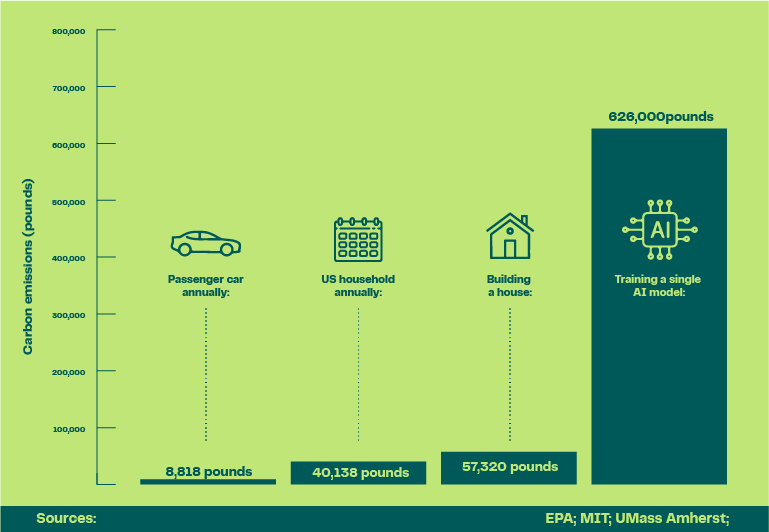Artificial Intelligence (AI) is a transformative force driving innovations across many sectors, including adtech. As we embrace AI’s benefits, it’s crucial to consider its environmental footprint. Given its intersection of data, technology, and consumer engagement, the adtech industry is uniquely positioned to reflect on and address these impacts.
Understanding the Impact
AI’s environmental impact primarily stems from the substantial energy demands required to train complex machine learning models and the data centers that power these operations. Training AI models by running complex algorithms through vast datasets multiple times to refine the model is a resource-intensive task requiring significant computation power and energy. Data centers, the backbone of AI as the core infrastructure, consume substantial energy. They not only house the servers where data is stored but also require cooling systems to maintain optimal operating temperatures, further increasing energy use. The energy source to power these facilities is often non-renewable, contributing to the sector’s carbon footprint.
A study by the University of Massachusetts, Amherst, showed that training a single AI model could generate carbon emissions equivalent to those of five cars over their lifespan—more than 626,000 pounds. This footprint is magnified within the adtech sector, where AI is extensively used to optimize ad targeting and analyze consumer behavior.

The Adtech Perspective
AI enables companies to process vast amounts of data for campaign optimization and predictive analytics. While these applications deliver significant business value, they also contribute to the industry’s carbon footprint.
AI is inherently data-intensive. The processing, analysis, and storage of massive amounts of consumer (or, in Ogury’s case, persona) data are central to creating advertising strategies that resonate with specific audiences. This data-centric approach necessitates continuous operation of energy-hungry data centers, which consume vast quantities of electricity and require substantial cooling mechanisms to prevent overheating, further escalating their energy intake.
Mitigating Environmental Impacts
Acknowledging the significant energy consumption of AI and adtech is a step towards remediation. There are numerous strategies to alleviate these impacts – and even use AI to curb overall carbon emissions. Here are 5 strategies that Ogury and other adtech companies using to mitigate the environmental impacts of AI:
1. Green computing: Adtech companies can adopt green computing practices, focusing on energy-efficient hardware and optimizing algorithms to reduce power consumption. Implementing more efficient data processing and storage solutions can also play a pivotal role in minimizing environmental impacts. In the context of AI, green algorithms can integrate across AI modalities and create tools for projects that help address their sustainability.
2. Renewable energy: Transitioning to or working with partners using renewable energy resources to power data centers is a crucial step. Companies like Google and Meta have already made significant strides in this direction, setting an example for the adtech industry.
3. Carbon offsetting: While reducing emissions is critical, carbon offsetting can also be a part of a holistic approach. Investing in environmental projects or renewable energy can compensate for the unavoidable emissions associated with AI operations.
For example, Ogury partnered with Greenly, one of the leading carbon management accounting platforms, to conduct a carbon footprint assessment of our activities. With this information, we can proactively shape our long-term strategy for creating sustainable operations.
4. Industry collaboration: Collective efforts can amplify impact. Adtech companies can collaborate on shared goals, such as developing industry-wide standards for sustainable AI practices and sharing best practices for energy efficiency.
5. Innovation in ad delivery: Exploring innovative ways to deliver ads that require less data and energy can also contribute to sustainability. Advanced AI algorithms can optimize the efficiency of ad delivery, reducing wasteful impressions and ensuring that ads reach their intended audience with minimal energy expenditure. Moreover, AI can aid in streamlining data processing workflows, enhancing algorithmic efficiency, and ultimately reducing the computational power required for ad targeting and analytics.
Ogury strives to innovate in this space whenever possible, including enhanced ad processing. Ogury receives billions of ad requests daily, meaning server energy ends up dedicated to requests that don’t end up in our pipeline. By creating an algorithm to throttle some of these requests, we are working towards optimizing our server energy use.
The Road Ahead
By adopting greener practices and fostering innovation in sustainable AI deployment, the adtech industry can reduce its environmental footprint and lead by example in the broader tech landscape. While the ecological impacts of AI are significant, they are not insurmountable.
Through conscious efforts to integrate sustainability into their operational fabric, adtech companies can mitigate these impacts, paving the way for a more sustainable future. According to a report by BCG, AI can aid in slashing greenhouse gas emissions by an amount equal to 5% to 10% of an organization’s carbon footprint, underscoring that responsible and sustainable use of AI can offset its environmental impact – and even increase an organization’s overall sustainability. Innovations such as predictive analytics for ad performance, more efficient data storage solutions, and the use of green algorithms can collectively contribute to a more sustainable adtech ecosystem.